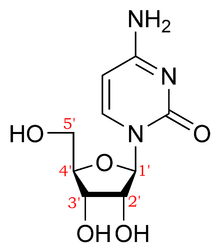- Nucleic acid nomenclature
-
Molecular biologists use several shorthand terms when referring to nucleic acid molecules, such as DNA and RNA, collectively referred to as nucleic acid nomenclature.
The most common is the representation of the base pairs as letters—an adenine nucleotide is abbreviated as A, guanine as G, cytosine as C, thymine as T, and in RNA, uracil as U.
Additionally, the positions of the carbons in the ribose sugar that forms the backbone of the nucleic acid chain are numbered, and are used to indicate the direction of nucleic acids (5'->3' versus 3'->5'), see directionality.
Expanded letter code
In addition to the conventional GATC symbols, there is an expanded letter code to indicate a position within a sequence that may be flexible when defining sequences.
Letter Nucleotide(s) included A A T T G G C C R G or A Y T or C M A or C K G or T S G or C W A or T H A or C or T B G or T or C V G or C or A D G or T or A N G or T or A or C For example, if the sequences known to bind protein X are known to be AAAAAAGAAA, AAAAAACAAA, AAAAAATAAA, and AAAAAAAAAA, this can be expressed as AAAAAANAAA.
Triple Helix Base Pairing
Watson and Crick base pairs are indicated by a "•" or a "-" or a "." (example: A•T, or poly(rC)•2poly(rC)).
Hoogsteen triple helix base pairs are indicated by a "*" or a ":" (example: C•G*G+, or T•A*T, or C•G*G, or T•A*A).
See also
Branches of Chemistry Physical chemistry Chemical kinetics · Chemical physics · Electrochemistry · Materials science · Photochemistry · Quantum chemistry · Solid-state chemistry · Spectroscopy · Surface chemistry · Thermochemistry
Organic chemistry Biochemistry · Biophysical chemistry · Bioinorganic chemistry · Bioorganic chemistry · Chemical biology · Medicinal chemistry · Organic chemistry · Organometallic chemistry · Pharmacy · Physical organic chemistry · Polymer chemistry ·
Inorganic chemistry Others List of biomolecules · List of inorganic compounds · List of organic compounds · Periodic table Natural science Physical science · Space science · Earth science · Life science
Categories:- DNA replication
- Nucleic acids
- Nucleotides
Wikimedia Foundation. 2010.

